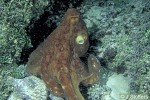Cook Islands Biodiversity Database
Species Page
Octopus cyanea
‘Eke Māori (MG)Daytime Octopus
Multimedia & Additional Resources
| Type | Description | Download |
| Adult, Rarotonga | 75KB | |
| Adult, Rarotonga | 47KB | |
| Adults in copula, Guam | 39KB | |
| Adult male in courtship colour, Guam | 50KB | |
| on Rarotonga (© Karl Traylor) | 518KB |
General Information
Cook Islands Distribution
| Southern Group: Present Makatea: | ||||||||
RR |
MG |
AT |
MK |
MT |
AK |
PL |
TK |
MN |
P |
^P |
^P |
^++++ |
|||||
| Northern Group: Present | |||||
TN |
MH |
RK |
PK |
NS |
SW |
P |
|||||
Scientific Taxonomy
Octopus cyanea Gray, 1849
TAXONOMY: ANIMALIA; MOLLUSCA; CEPHALOPODA; COLEOIDA; Octopoda; OCTOPODIDAE
More Information
GENERAL NOTE: Octopuses live for 12 to 18 months. After a month dispersing in the plankton they settle and take 11 months to reach their full-size and to become sexually mature. The male may live a further 6 months. When a mature male is touched by a female, he becomes uniformly white and while walking-tall towards her he flashes dramatic black stripes. If the female allows, he searches for the oviduct opening within her mantle cavity with the specialised tip (=hectocotylus) of his third right arm. If all goes well, they settle in this position for an hour or more, and every 2 or 3 minutes the male pushes another small sperm-sac (=spermatophore) along a groove in the arm into the oviduct, where each independently expels its sperm. Over the next few weeks the female develops 150,000-700,000 eggs and attaches them to the ceiling of her den. Over the next couple of months she protects, ventilates and cleans the eggs, each hatching in a month. During this process she does not eat, and soon after she dies.
Vouchers & References
Vouchers:
Mangaia: specimen, College, 9/2000, ID GMcC. Mauke: field-specimen, College collection, 3/2001, ID GMcC. Aitutaki: field-specimen, NBSAP School, 12/2000, sans spot, putative ID GM.
References:
None recorded.
Data Update History (information):
zTX, zB02, zM02, zD02
Web Resources
Citation Information
McCormack, Gerald (2007) Cook Islands Biodiversity Database, Version 2007.2. Cook Islands Natural Heritage Trust, Rarotonga. Online at http://cookislands.bishopmuseum.org. ![]()
Please refer to our use policy.

